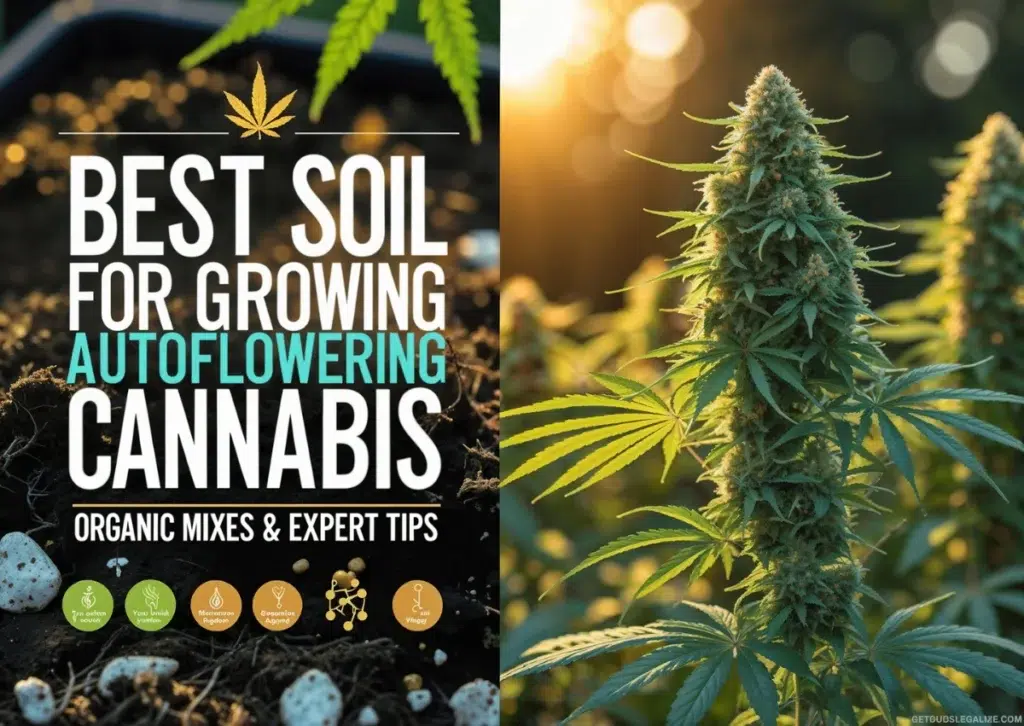How to Get Rid of Aphids on Cannabis Plants: Identify, and Solutions
If you are growing cannabis, you may encounter a common pest problem: aphids. These tiny insects can cause serious damage to your plants by sucking the sap from the leaves and stem and spreading diseases and viruses.
Aphids are common pests that can affect cannabis plants and reduce their quality and yield. In this blog post, we will show you how to identify aphids on cannabis plants and how to control them effectively.
What Are Aphids?


Aphids are small, soft-bodied insects that feed on plant sap, also known as plant lice or greenflies. They have piercing-sucking mouthparts that allow them to suck the sap from the phloem, the nutrient-rich tissue that transports sugars and other organic compounds from the leaves to the rest of the plant.
Aphids lay eggs under the leaf of plants and can cause serious damage to plants by reducing their vigor, stunting their growth, curling their leaves, and transmitting viral diseases. Some aphids also secrete a sticky substance called honeydew, which attracts ants and other insects and can lead to the growth of sooty mold on the plant surface.
Aphids belong to the order Hemiptera, which includes other sap-feeding insects such as cicadas, leafhoppers, and scale insects. There are more than 4,000 species of aphids worldwide, and they can be found on almost any kind of plant.
Some aphids are host specific, meaning they feed on only one or a few related plant species, while others are generalists and can feed on a wide range of plants. They vary in color, shape, and size, but most are less than 5mm long. They have a pair of tube-like structures called cornicles at the end of their abdomens, which they use to expel defensive chemicals when threatened.
Aphids have a complex cycle of life involving both sexual and asexual reproduction. This allows them to multiply rapidly and form large colonies on their host plants. Some aphids can also produce winged forms which can disperse to new plants or locations.
In some species and under certain environmental conditions, aphids can switch to sexual reproduction and produce male and female offspring that can mate and produce eggs. These eggs can overwinter and hatch in the spring, starting a new generation of aphids.
What Causes an Aphids Infestation?
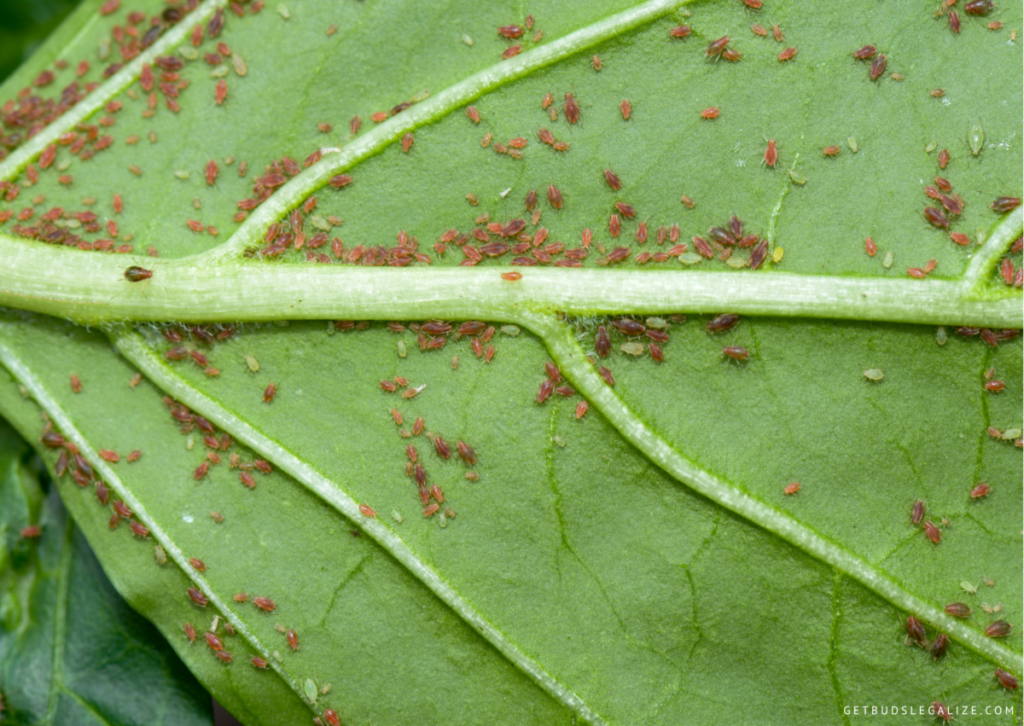
Aphids can infest weed plants for various reasons, such as:
- Poor hygiene and sanitation: If you do not clean your grow area regularly and remove any dead or diseased plant material, you may create a favorable environment for aphids and other pests.
- Overwatering and overfeeding: If you water or fertilize your cannabis plants too much, you may make them more susceptible to aphid attacks. Aphids prefer plants that have high nitrogen levels and soft tissues.
- Lack of airflow and ventilation: If you do not provide enough airflow and ventilation for your cannabis plants, you may create a humid and stagnant atmosphere in that aphids thrive.
- Bringing in infected plants or clones: If you buy or receive cannabis plants or clones from an unreliable source, you may introduce aphids or their eggs into your grow area. Always inspect your plants or clones carefully before bringing them in.
- Outdoor factors: If you grow cannabis outdoors or in a greenhouse, you may expose your plants to aphids that come from nearby plants or crops. You may also attract aphids with certain flowers or herbs that they like.
How to Spot Aphids on Marijuana Plants
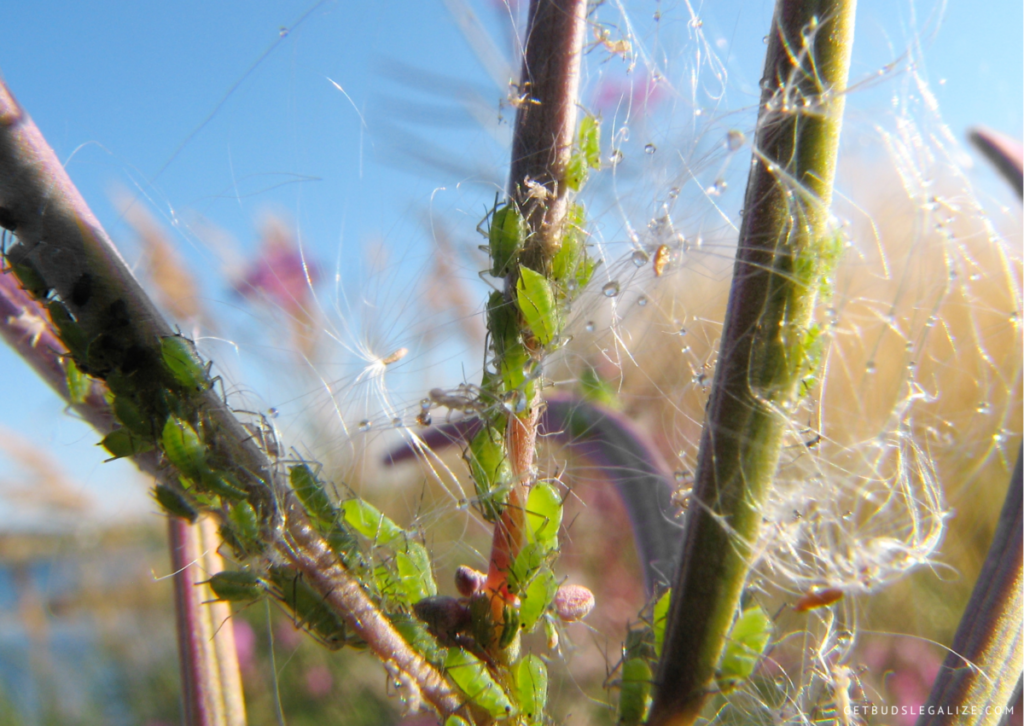
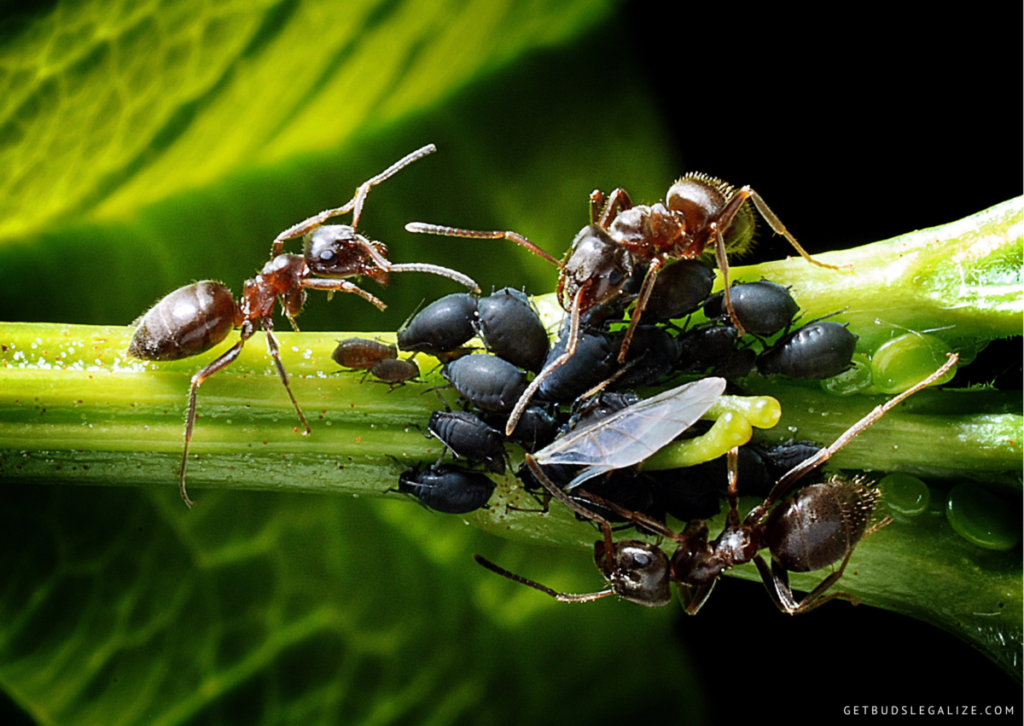
The best way to spot aphids on weed plants is to inspect your plants regularly and look for signs of damage or infestation. Some of the symptoms of aphid infestation are:
- Tiny insects in various colors on the undersides of leaves or on new growth: Aphids are usually found on the undersides of leaves or on new growth, where they can access the plant’s sap more easily. Aphids can vary in color depending on their species and host plant, but they are typically green, yellow, black, brown, gray, or pink. They have pear-shaped bodies with long antennae and two tubes called cornicles at the rear end.
- Small holes or bite marks on leaves: Aphids use their piercing mouthparts to suck the sap from the leaves, leaving behind tiny holes or wounds. These can make the leaves look speckled or mottled.
- Yellowing, curling, wilting, or dropping leaves: Aphids suck the sap from the plant’s leaves and stems, depriving them of nutrients and water. This can result in leaf discoloration, distortion, wilting, or stunting.
- Sticky honeydew on leaves or stems: Aphids excrete a sugary substance called honeydew as they feed on the plant’s sap. Honeydew can make the leaves and stems sticky and shiny, and attract ants or other insects that feed on it.
- Black sooty mold on leaves or stems: Honeydew can also promote the growth of a black fungus called sooty mold on the plant’s surface. This fungus can reduce the plant’s ability to photosynthesize and affect its appearance and quality.
- Ants or other insects on or near the plants: Ants often form a mutualistic relationship with aphids, protecting them from predators and parasites in exchange for honeydew. Ants can also carry aphids to new plants and spread the infestation. Other insects that may be attracted by honeydew or aphids include ladybugs, lacewings, hoverflies, wasps, and spiders.
- Small white skins shed by aphids on the plant surface: Aphids molt several times during their life cycle, leaving behind their white cast skins on the plant. These skins can indicate the presence and size of the aphid population on the plant.
If you see any of these signs, you should act quickly and treat your plants before the infestation gets out of control.
How to Get Rid of Aphids Permanently
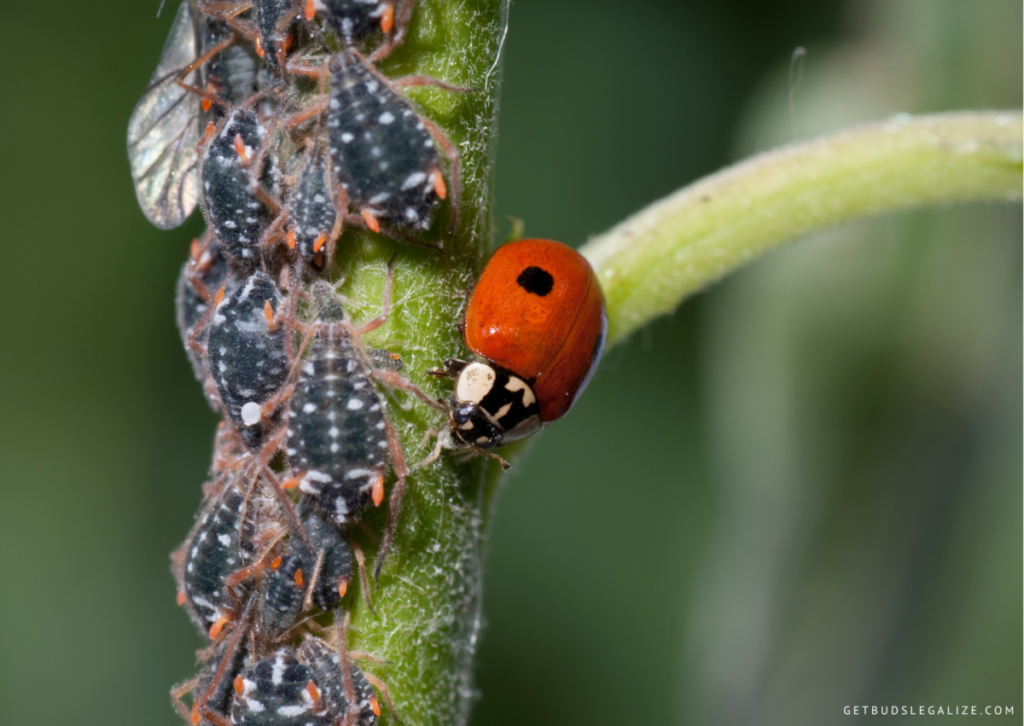
If you already have Aphid infestations of them on your marijuana plants, don’t panic. There are several ways to remove aphids without using harsh chemical pesticides that can harm your plants or yourself. Here are some methods to try:
1. Manually Remove:
You can use a strong stream of water to blast off the aphids from your cannabis plants. You can also use a cloth or a brush to wipe them off manually. Make sure to dispose of them properly and clean your tools afterward.
2. Prune and Dispose of Infected Parts:
If some parts of your plants are heavily infested with aphids, you may want to prune them off and dispose of them in a sealed bag or bin. This can prevent the aphids from spreading to other parts of the plant or to other plants nearby.
3. Spray with Water:
A strong blast of water can help you remove a lot of aphids from your plants. Spray your plants with a strong blast of water every few days until you no longer see aphids. Be sure to spray the undersides of the leaves and stems as well.
4. Use Insecticidal Soap:
This is a natural product that kills aphids by disrupting their cell membranes and dehydrating them. You can buy it from a garden center or make your own by mixing 1 teaspoon of mild liquid soap with 1 liter of water. Spray the solution on the affected plants, making sure to cover both sides of the leaves and the stems. Repeat every few days until you see no more signs of aphids.
5. Use Diatomaceous Earth or Silica Gel:
These are powdery substances that can dehydrate and kill aphids by piercing their exoskeletons. Sprinkle some on your plants and around your growing area. Be careful not to inhale them as they can irritate your lungs.
6. Introduce Natural Predators:
You can introduce natural predators that feed on aphids into your grow area, such as Lady beetles, lacewings, parasitic wasps, hoverflies, or predatory mites. These beneficial bugs can help reduce the aphid population naturally and without harming your marijuana plants.
7. Use Neem Oil:
You can spray it on your cannabis plants to kill aphids (spider mites, fungus gnats, thrips, whiteflies, etc) and their eggs. The oil of Neem is a natural insecticide that disrupts the hormonal system of aphids and prevents them from reproducing. It also has antifungal and antibacterial properties that can protect your plants from diseases.
8. Use Essential Oils:
You can use such as peppermint, rosemary, clove, or thyme oil, to repel aphids from your cannabis plants. Essential oils have strong aromas that interfere with the sensory organs of aphids and deter them from feeding on your plants. You can mix a few drops of essential oil with water and mild soap and spray it on your plants.
9. Use Tomato Leaf Spray:
You can make a homemade aphid spray from tomato leaves, which contain alkaloids that are toxic to aphids. You can chop up some tomato leaves and soak them in water overnight, then strain them and spray the liquid on the plants.
10. Use Garlic and Onion Spray:
You can also make a homemade garlic and onion spray, which contains sulfur compounds that repel aphids. To prepare it you can chop one onion and two cloves of garlic and add two cups of water to the mixture. After resting, squeeze out the pulp and use the mixture to spray your plants.
11. Use Vinegar Spray:
You can make a simple natural pesticide with vinegar, which is acidic and kills aphids on contact. You can mix one tablespoon of vinegar with one tablespoon of Castile soap and one gallon of water. Then pour the solution into a spray bottle and spray it on your plants.
10 Useful Tips to Prevent Aphids in Your Next Cannabis Garden
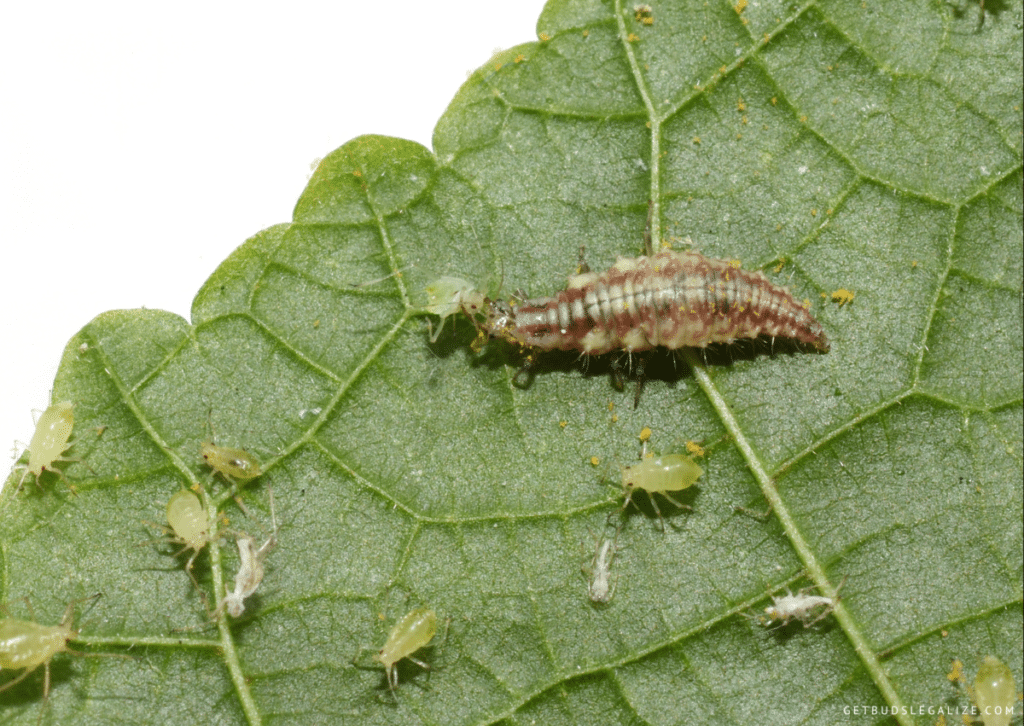
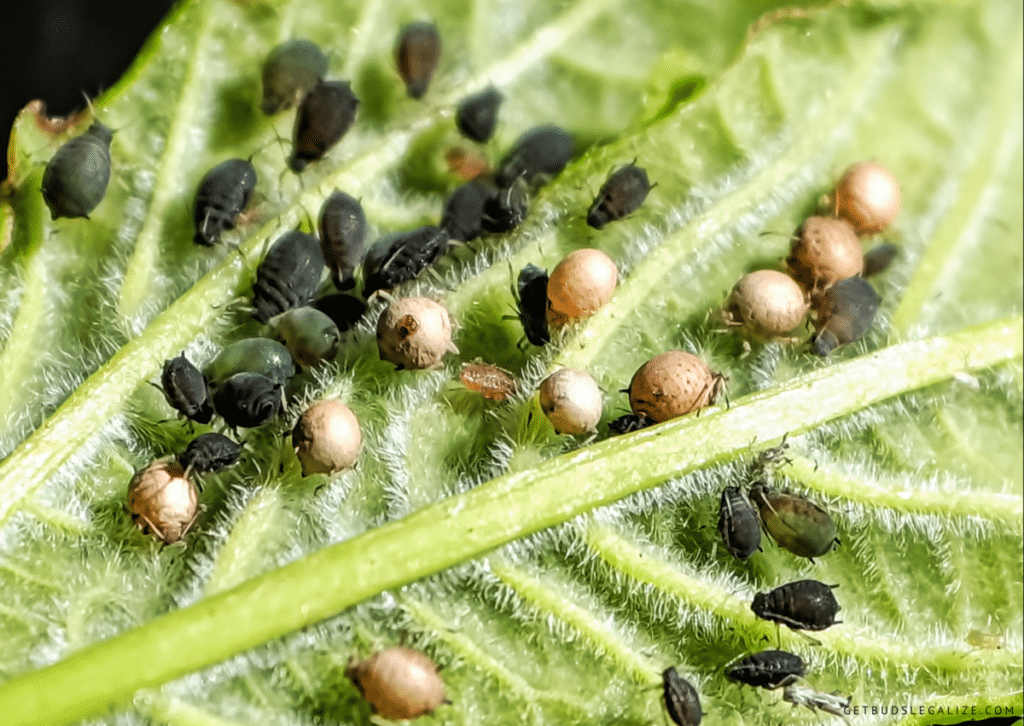
To prevent aphids from attacking your weed plants, you can take some preventive measures such as:
1. Choose Resistant Strains:
Some cannabis strains are more resistant to pests than others, such as Durban Poison, Purple Haze, Auto Afghan Kush, Satori, Cash Crop Auto, Sweet Tooth Auto, Onyx Auto, Strawberry Amnesia, and Lemon Haze. Planting these strains can reduce the chances of aphid infestation.
2. Apply Neem Oil, Insecticidal Soap, or Other Organic Pesticides to Your Plants as a Preventive Treatment:
These natural products can repel or kill aphids without harming plants or the environment. You can spray them on your plants every week or as needed. Make sure to cover all parts of your plants, especially the undersides of the leaves where aphids like to hide.
3. Avoid Overwatering or Overfertilizing Your Plants, as This Can Attract Aphids:
Aphids prefer moist and lush conditions, so keeping your plants on the dry side and using moderate amounts of nutrients can deter them. Overwatering and overfertilizing can also weaken your plants and make them more susceptible to pests and diseases.
4. Keep Your Grow Area Clean and Free of Weeds, Debris, and Other Potential Hosts for Aphids:
Aphids can easily spread from one plant to another, especially if they are crowded or stressed. To avoid this, you should keep your grow room or grow area clean and well-ventilated. Remove any dead or diseased plant material, prune excess foliage, and remove unwanted plants that could harbor aphids.
5. Quarantine Any New Plants Before Introducing Them to Your Grow Area:
If you buy or receive any new cannabis plants or clones, you should inspect them carefully for any signs of aphids or other pests. You should also isolate them from your existing plants for at least two weeks and treat them with neem oil or insecticidal soap before bringing them into your grow area.
6. Prune and Dispose of Infected Leaves:
If you notice any signs of damage from aphids on your plants, such as yellowing, curling, or wilting of leaves, you should prune them off and dispose of them properly. This can prevent the aphids from spreading to other parts of the plant or to other plants in your grow area. Make sure to sterilize your scissors or pruning tools after each use to avoid contaminating healthy plants.
7. Spray Your Plants With Natural or Organic Sprays:
These sprays can suffocate or repel aphids, but they may also harm beneficial insects or leave residues on your crops. You should always test a small area of your plants before applying any spray and follow the label instructions carefully. You should also avoid spraying during hot or sunny days, which may cause leaf burn.
8. Employ Natural Predators:
One of the most effective ways to control aphids is to introduce their natural enemies into your grow area. These include lady beetles, green lacewings, and birds that feed on aphids and keep their population in check. You can buy them online or from garden centers and release them on your plants. You can also attract birds by providing them with water, food, and shelter near your grow area.
9. Grow Companion Plants:
Another way to use nature to your advantage is to grow plants that can help you deal with aphids:
- Some plants can attract predatory insects that eat aphids, such as dill, fennel, coriander, yarrow, and marigold.
- Some plants can repel aphids by their smell or taste, such as garlic, onion, chives, mint, basil, oregano, sage, rosemary, and lavender.
- Some plants can trap aphids with their sticky hairs or sap, such as sunflower, nasturtium, petunia, and geranium.
10. Use Sticky Traps:
This is another option for catching and killing aphids. These are yellow or blue cards coated with a sticky substance that attracts and traps aphids. You can place these traps near your plants or hang them from the branches. You should check and replace the traps regularly to ensure their effectiveness.
CONCLUSION
Aphids are common pests that can damage your cannabis growth and reduce your yield. However, you can control or prevent them with various natural methods that are safe for you and your plants. By using manual removal, natural predators, and organic insecticides, you can get rid of aphids effectively and organically.
Aphids on Cannabis - FAQs
Aphids are small insects that feed on the sap of plants, including marijuana. They can cause damage to the leaves, stems, and buds of cannabis plants by sucking out their nutrients and leaving behind honeydew, a sticky substance that attracts mold and other pests. Aphids can also transmit viruses and bacteria that can harm the health and quality of cannabis plants. Therefore, aphids can ruin cannabis if they are not controlled or prevented.
Getting rid of aphids during flowering can be a challenge, but not impossible. Here are some steps you can follow to protect your cannabis plants from these pests:
- Quarantine any infested plants and remove them from your grow area.
- Use a soft brush or a spray of water to dislodge the aphids from the leaves and stems of your plants.
- Apply an organic pest killer, such as oil of neem, vinegar spray, or a homemade spray of water, dish soap, and cayenne pepper, to the affected areas of your plants. Repeat this every 2-3 days for 2 weeks or until you see no more signs of aphids.
- Avoid using chemical insecticides that can harm your plants or contaminate your buds. If you have to use them, do so sparingly and only in the early stages of flowering.
- Improve the air circulation and ventilation in your grow space to prevent mold and fungus from growing on the honeydew that aphids produce.
- Monitor your plants regularly and act quickly if you spot any new aphids or eggs.
If you notice aphids on your plants late in the flowering stage, right before harvest, you need to act quickly and carefully to get rid of them without harming your buds. Here are some steps you can take:
- Prune off any heavily infested leaves or branches and dispose of them in a sealed bag.
- Spray your plants with a strong jet of water to knock off as many aphids as possible. Do this early in the morning or late at night to avoid burning your plants.
- Apply a natural insecticide like neem oil or garlic-onion spray to your plants. Follow care label instructions if possible and avoid spraying your buds directly.
- Repeat the spraying every few days until you see no more signs of aphids.
- Harvest your buds as soon as they are ready and inspect them for any remaining aphids or eggs. Wash them gently with water and hydrogen peroxide if needed.
Aphids are small insects that feed on the sap of cannabis plants, causing damage and stress. The best treatment for aphids on cannabis depends on the severity of the infestation and the stage of growth of the plants. Some possible treatments are:
- Spray the plants with a solution of water and insecticidal soap, neem oil, or pyrethrin: These are natural pesticides that can kill aphids without harming plants or humans. However, they should be used with caution and only as a last resort, as they can affect the taste and quality of the buds.
- Introducing beneficial bugs: These are natural predators that can control aphid populations by feeding on them or laying eggs inside them. They can be purchased online or from garden centers and released on the plants. They are safe for plants and humans and do not affect the taste or quality of the buds.
- Pruning and trimming the plants to remove any dead or damaged leaves or stems that may harbor aphids: This can also improve air circulation and light penetration, which can reduce the risk of mold and other diseases. Pruning and trimming should be done carefully and sparingly, as it can stress the plants and affect their yield.
ILGM Fertilizer

- From seedling to harvest, give your plants everything they need.
- Enough for feeding at least 5 plants.
- Discounted Package Deal
- Works well in soil and hydroponics
- The best way to treat your plants
ILGM Plant Protector

- Protect your cannabis from diseases and harmful pests.
- Contains three 20 ml bottles.
- Enough supplies to protect 20 plants.
- It can be used in soil and hydroponic











